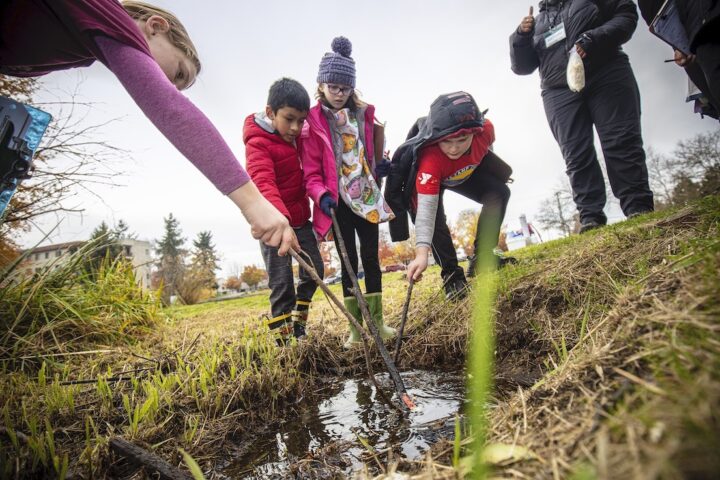How can environmental educators practice intersectional environmentalism?

WHY IT MATTERS TO YOU
- Environmental educators should take up an intersectional approach, disrupt human exceptionalism through activities that address intersecting systems of oppression, and help people build caring relationships with places & other species.
- Organizational leadership should expand their mission to include the intersecting empowerment of people and place.
- Board Members and Donors should consider funding models for reparations to the Indigenous people whose land environmental organizations profit from, and prioritize partnering with organizations led by BIPOC.
What Is The Issue?
Black, Indigenous, and People of Color (BIPOC) communities have histories of environmentalism and relationships with land that are often made invisible in environmental education. At the same time, BIPOC communities face disproportionate social and environmental injustices. Environmental educators must foreground the diverse ways that BIPOC’s lived experiences, community practices, adaptive resilience, and social justice movements can undergird environmentalism. This can help desettle white-dominant narratives and build relationships between humans and with the natural world.
Image: Photo courtesy of IslandWood
Authors:
BY LAURA BROWN, CHRISTINA GUEVARA, RAE JING HAN, ABBY RHINEHART & DÉANA SCIPIO
Reflection Questions
- Whose histories, values, beliefs, and imagined futures are embedded within your programs? What counts as “nature”? Whose ways of relating with nature are modeled in your program?
- Who holds decision-making responsibilities within your organization for environmental experiences? To what extent are BIPOC educators recruited, supported, and empowered?
- How might you center learners’ and communities’ knowledges and experiences in environmental efforts?
Things to Consider
- White western environmentalism is a pervasive approach that tends to reinforce systems of oppression (e.g., racism, heteropatriarchy, settler colonialism, ableism, etc.). For example, mainstream conservation movements frequently perpetuate exclusionary policies, make the existing relationships marginalized communities have with lands and waters invisible, and fail to address the realities of environmental racism.
- This traditional view of environmentalism is often built on the misconception that humans are separate from nature, leading to the belief that people can preserve naturescapes “untouched” by humans. This perspective ignores complex histories of human-nature relationships and the complex needs of many creatures.
- Intersectional environmentalism is a movement that advocates for the protection of both people and the planet, building from the interconnectedness of injustices imposed upon marginalized communities and the earth. It builds from the intersectionality framework that generally describes how race, class, gender, ability, and other social classifications often overlap to create interdependent systems of oppression and privilege.
- There are many generative approaches to environmentalism across BIPOC communities. It is practiced in various ways within and across intersecting identities to fulfill specific aims. Moving beyond narrow definitions of environmentalism and engaging respectfully with diverse practices within environmental education can contribute to more just futures for human and more-than-human communities.
Attending to Equity
- Your visitors should have opportunities to learn about how the concepts in this brief play out both at your site and in the world by directly experiencing them.
- Highlighting different modes of activity (e.g. recreation, work, intergenerational learning, ceremony) shows how BIPOC and LGBTQ+ communities engage in the outdoors in various ways.
Recommended Actions You Can Take
- Learn how BIPOC communities, often led by womxn, continue to sustain and evolve their ancestral practices. Centering these accounts in environmental education helps disrupt misconceptions that BIPOC communities’ environmental practices exist solely in the past and that BIPOC have not been part of environmental movements. For example, you can: (a) explore Black Feminist Ecological Thought, (b) learn about Black-owned farms and food gardens in your area, (c) familiarize yourself with conservation cultura, and (d) engage with BIPOC who continue to practice sustainable fishing.
- Since all environmental programs take place on the lands of Indigenous peoples and nations, it is important to foster a critical pedagogy of place and avoid problematic practices like cultural appropriation, tokenism, and extracted BIPOC labor. See Indigenous STEAM, Queer Nature, and Learning in Places for frameworks to building authentic community relations.
- Co-creating culturally sustaining curriculum with BIPOC students, educators, and community members can help revitalize BIPOC knowledge systems. To get started, you can engage families in a socio-ecological histories of places walk from Learning in Places.
ALSO SEE STEM TEACHING TOOLS
STEM Teaching Tools content copyright 2014-22 UW Institute for Science + Math Education. All rights reserved.
This site is primarily funded by the National Science Foundation (NSF) through Award #1920249 (previously through Awards #1238253 and #1854059). Opinions expressed are not those of any funding agency.
Work is licensed under a Creative Commons Attribution-ShareAlike 4.0 Unported License. Others may adapt with attribution. Funded by the National Science Foundation (NSF). Opinions expressed are not those of any funding agency.


 Email Feedback
Email Feedback

